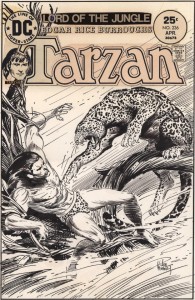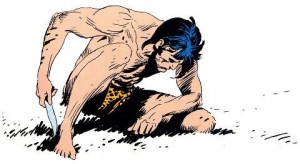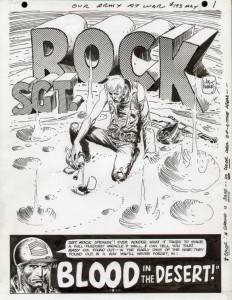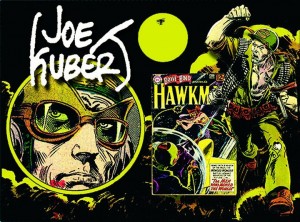Along with his contemporaries, Carmine Infantino and Gil Kane, Joe Kubert entered the comic book field in the 1940s as a teenager drawing for DC Comics, then went on to become one of the giants of the medium, an artist whose style is unmistakable – and unforgettable, the most expressive pen-and-brush comic book artist of his generation.
Kubert’s name and style became synonymous with war comics during the Silver Age because of years of service drawing World War II’s heroic American Sgt. Rock, and then later, the offbeat antihero, World War I German flyer Enemy Ace. Both became signature characters; Kubert’s gritty pen line and bold brushwork perfectly suited writer and editor Bob Kanigher’s emotionally wrenching writing. “Some people have asked me if the war stuff was material I especially liked doing,” Kubert said, “and my answer has been no, it wasn’t. Bob had an opening, he needed war stories, and he asked me if I could do it. I said sure, give me any subject matter and I’ll draw it. It wasn’t because I had any particular feeling for it — I put as much effort into doing it as I would in any kind of story.”
 Even superhero stories: in the early ‘60s, Kubert maintained continuity with his ‘40s roots by returning to Hawkman, a character rendered by many artists since, but given his most definitive treatment by Kubert, despite a brief run of only six issues. What accounts for Kubert’s lasting popularity and legend-in-his-own-time status? “I happen to love to draw,” he said in 2003. “And I happen to love to draw comic books. I enjoy it as much now, probably more, than I did before.”
Even superhero stories: in the early ‘60s, Kubert maintained continuity with his ‘40s roots by returning to Hawkman, a character rendered by many artists since, but given his most definitive treatment by Kubert, despite a brief run of only six issues. What accounts for Kubert’s lasting popularity and legend-in-his-own-time status? “I happen to love to draw,” he said in 2003. “And I happen to love to draw comic books. I enjoy it as much now, probably more, than I did before.”
Sgt. Rock, Enemy Ace and Hawkman are just three of the characters whom Kubert was, and always will be, the definitive artist of. And, of course, no offense to the legacies of the great Hal Foster and Burne Hogarth, who illustrated Tarzan during the Golden Age of The Comic Strip, but Kubert will forever be Tarzan’s greatest, most definitive artist; never before has the exact style of an artist–the savage brush strokes and organic, sinewy pen lines that only Kubert has ever made–been so perfectly, beautifully matched to the exact character and that character’s milieu.
 Even in this simple illustration, Kubert was to Tarzan as Sean Connery was to James Bond!
Even in this simple illustration, Kubert was to Tarzan as Sean Connery was to James Bond!
How many covers hath the great Kubert drawn? Along with Jack “King” Kirby (1513) and Curt (Superman family) Swan (1004), Kubert drew as many (1256) as those two titans–and as many, if not more, incredibly beautiful covers, like my twin favorites here, separated by almost a decade (Enemy Ace 1968, Ragman 1976)!
 As we look back 500 years ago on the Renaissance masters of the human figure like Michelangelo and Raphael, so too will future art historians 500 years from now look back on an artistic giant who walked the earth in our time, a graphic stylist nonpareil who made pen and brush marks like no one on earth before or after him: the one, the only…Joe Kubert! We shall not see the likes of him for generations.
As we look back 500 years ago on the Renaissance masters of the human figure like Michelangelo and Raphael, so too will future art historians 500 years from now look back on an artistic giant who walked the earth in our time, a graphic stylist nonpareil who made pen and brush marks like no one on earth before or after him: the one, the only…Joe Kubert! We shall not see the likes of him for generations.
“…from his pen came the sound and the fury, the loneliness, the silence, the exhaustion, the pity and the pitiless, the poetry and the mud. Black and white more eloquent than erupting blood. It was a miracle – called Joe Kubert.”
–Robert Kanigher, Kubert’s soulmate/writer/ partner on Sgt. Rock, Enemy Ace & Ragman
You can read more of the fine work of Arlen Schumer on comics and the Twilight Zone on his website, The Art and Writing of Arlen Schumer.







There are no responses yet